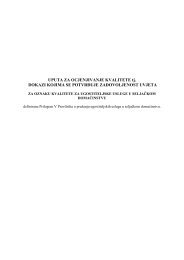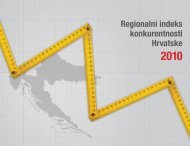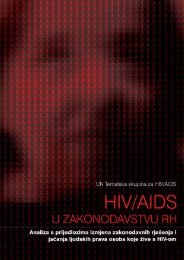WEB engleska verzija end.indd - UNDP Croatia
WEB engleska verzija end.indd - UNDP Croatia
WEB engleska verzija end.indd - UNDP Croatia
- No tags were found...
You also want an ePaper? Increase the reach of your titles
YUMPU automatically turns print PDFs into web optimized ePapers that Google loves.
KEY CHALLENGESCHAPTER 4In welfare state restructuring, so-called activationpolicies 185 or ‘active labour market policies’have sometimes been emphasised above otherpolicy measures. Sometimes, the balance betweenevidence-based and ideological motivation for suchschemes appears distorted, and their effects appearto vary dep<strong>end</strong>ing on the nature of the schemes,their assumptions regarding the labour market,and the balance between incentives and sanctionswhich they contain. An overview of ‘workfare’ in aninternational perspective (Lødemel and Trickey (eds.),2001) shows the existence of common problems ina variety of schemes, precisely deriving from the factthat they are compulsory, work based and targetedto a population facing formidable barriers to work. A‘social division of workfare’ which mirrors that of thelabour market as a whole, with a ‘creaming off’ of themost employable increases the further exclusion,through ‘sink options’, of the more disadvantagedand vulnerable groups. Hence, great care needs to betaken when devising programmes for ‘hard-to-place’groups with participants’ rights guaranteed and,above all, appropriate evaluation undertaken.There is a need to be far more circumspect in the connectionsbetween policies to increase employmentand policies to reduce social exclusion. Too close alink, in which policies to reduce social exclusion focusexclusively on activation policies is unlikely to yieldpositive results and could, indeed, worsen exclusion.It is beyond question that more resources need tobe devoted to active rather than passive measures,combining national best practices with locally tailoredschemes. Care must be taken, however, to avoidfurther stigmatising vulnerable groups.In terms of older people and members of the labourforce who currently do not receive, or who appear unlikelyto receive, a subsistence pension, there may bea need to revisit the idea of a ‘social pension’ perhapsin conjunction with some kind of special fund. Issuesaround the work-life balance require more concertedfocus on child care policies and, in particular, theprovision of day care, through a mixture of providers,funding arrangements, tax and other subsidies, andeven voucher schemes. Longer-term care arrangementsfor vulnerable older people, adults and childrenwith disabilities and those living with recurrentchronic illnesses require more flexible provision and,above all, a shift so that resources follow clients ratherthan being ‘tied up’ in existing structures. New formsof community-based micro-insurance schemes willbe needed, in addition to a new ‘zonal’ social policywhich seeks to challenge multiple disadvantages.In addition, as developed below, there is a need tointegrate fiscal and social policies in a more coherentand sophisticated way in <strong>Croatia</strong>.While overall, <strong>Croatia</strong> performs well in terms of thediffusion of Information and Communication Technology(ICT), with a ranking of 45th in the ICT diffusionindex, and scores particularly highly in terms ofaccess (UNCTAD, 2006; 49), this masks a considerableregional variation. The <strong>UNDP</strong> Quality of Life Surveyshows that only 22.7% of respondents used the internetfrequently in the month before the study; some12.7% used it occasionally and 63.7% not at all (<strong>UNDP</strong>,2006a; 30). Variations in frequent use were similarto the difference in rates of understanding writtenEnglish, with usages most common amongst men,younger respondents, those with more education,and those living in urban areas. The County of Istriaand the City of Zagreb had rates of frequent usagealmost four times that of the county with the lowestrate. More work is clearly needed on the relationshipbetween e-exclusion and other forms of social exclusion,and it is important that initiatives such as thee-<strong>Croatia</strong> initiative, address the needs of marginalizedand disadvantages groups and regions moresystematically.4.5 Conclusion -- ‘smart’ social policy?Over and above the specific policy recomm<strong>end</strong>ationsoutlined above, there is a need for ‘smart’ socialpolicies free of ideology and that are evidence-based.The discussion of social policy framed in terms of ‘freeriding’ and ‘double dipping’ needs to be supportedby evidence, rather than asserted. One of the mostimportant aspects of this is to calculate precisely theextent and tr<strong>end</strong> of state social exp<strong>end</strong>itures. It oftenseems that figures in this regard, based on questionablecalculations, continue to circulate, giving theimpression that <strong>Croatia</strong> is a high social sp<strong>end</strong>ingcountry which, in many ways, is far from the truthand conceals a more complex picture. Data from the185 Defined as „a set of policies/measures/instruments aimed at integrating unemplyed social assistance recipients into the labour marketand improving their economic and social inclusion.“ (Hanesch and Balzter, 2001; 3).143

















